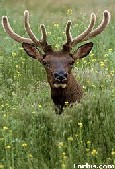|
OVERVIEW
HISTORY
ACTORS
MAPS
DIMENSIONS:
ecosystem
wildlife
economic
policy
recreation/aesthetic
social
STUDY
TEAM
REFERENCES
|
 |
HISTORY OF ELK MANAGEMENT IN YELLOWSTONE NATIONAL PARK
|

Pre-National Park Service (1872-1916):
-
In 1872 Yellowstone became the nation’s first National
Park, established to protect the park’s thermal and geologic
wonders, not its wilderness. In the early years of the park, market
hunting was allowed on big-game species, namely elk. In addition, the aggressive reduction
by park managers of predators such as wolves, coyotes and mountain
lions, was also occurring.
However, Congress did not provide funding to the Secretary
of Interior for protection of natural features or wildlife in
the park. As a
result, poachers were rampant in the park, and elk were significantly
reduced.
- In
1883 park managers recognized the loss of park wildlife and
subsequently banned all public hunting in the park.
- Punishment for poaching
was removal from the park.
But in 1884 a notorious poacher was arrested by army
officials after he had already killed several bison.
The incident brought about the passing of a bill “to
protect the birds and animals of Yellowstone National Park.”
This was the first time a National Park was given legal
authority to arrest and prosecute poachers.
- In
1886 the U.S. Cavalry took over responsibility for Yellowstone. This came about as a result of an earlier
army expedition to the park where it was discovered that massive
herds of ungulates, especially elk, had been slaughtered for
their hides. They issued an order against all removal
from the park. Although
Congress had not financially supported the Secretary of Interior
in managing the park, it now supported the military administration
of the park for the next thirty years.
Early days of National Park Service (1916-late 1960’s):
- In
the early years of the NPS, park officials continued to aggressively
reduce predators in YNP.
Consequently, wolves were completely eliminated from
the park by 1930, thus releasing the elk from loss due to predation.
- From about 1935 to 1968,
park officials controlled elk and bison with a "cull program"
which aimed to shoot and/or trap and remove animals to meet
an area’s carrying capacity. In the early 1960’s,
the size of man-induced herd reductions led to public outcry
and U.S. Senate hearings reviewing wildlife management policy
in Yellowstone. By
the late 1960’s, wildlife management policy shifted direction. They began a trial period of “hands-off” management.
The shift to natural systems management (late 1960’s to
present):
- Although little information
regarding the natural function of elk and bison populations
existed to date, park managers were of the opinion that Yellowstone
would be a good place to learn about how animal populations
work in an uncontrolled setting. In addition, letting nature
"take its course" allowed the National Park to resolve the controversy
surrounding elk management. Public critics would be less likely
to implicate park officials for faulty management when natural
regulation policy has been applied.
- The
"Natural Regulation" Paradigm: In 1974, the park master
plan states, “Yellowstone should be a place where all the
resources in a wild land environment are subject to minimal
management." Under natural regulation, human interference
should be minimal to non-existent, thereby allowing nature to
control animal numbers. This policy is still implemented in
YNP today. In fact, Yellowstone is the only National
Park in the lower 48 thought to be large enough to test natural
regulation. Today, climate, forage quantity and quality, predation
and animal behavior are relied upon to regulate elk in Yellowstone.
|